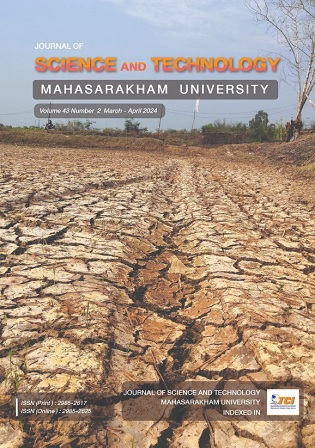การเรียนรู้ของเครื่องเพื่อทำนายระดับความรุนแรงของความผิดปกติของความยืดหยุ่นปอดของพนักงานโรงงาน
Main Article Content
บทคัดย่อ
กลุ่มโรคที่มีความผิดปกติของความยืดหยุ่นของปอดโดยเฉพาะอย่างยิ่งโรคนิวโมโคนิโอซีส (Pneumoconiosis) เป็นโรคที่พบมากในผู้คนที่มีการสัมผัสสภาพแวดล้อมที่มีฝุ่นแร่ การตรวจสมรรถภาพปอดด้วยวิธีสไปโรเมตรีย์ (Spirometry) เป็นวิธีมาตรฐานในการทดสอบสมรรถภาพการทํางานของปอด อย่างไรก็ตามวิธีดังกล่าวมีข้อจํากัดเนื่องจากค่าใช้จ่ายและอุปกรณ์ในการตรวจมีราคาแพง และประสบการณ์ของผู้อ่านผลการตรวจ ส่งผลให้ผู้พนักงานกลุ่มเสี่ยงไม่สามารถเข้าถึงการตรวจสมรรถภาพปอดได้ทันท่วงที การศึกษานี้มีวัตถุประสงค์เพื่อนําการเรียนรู้ของเครื่องมาใช้ทำนายระดับความรุนแรงของความผิดปกติของความยืดหยุ่นของปอดเบื้องต้น ก่อนที่จะนําไปสู่การตรวจสไปโรเมตรีย์ต่อไป โดยแบ่งระดับความรุนแรงของความยืดหยุ่นของปอดเป็น 3 กลุ่ม คือ กลุ่มปกติ รุนแรงน้อย และ รุนแรงปานกลางถึงมาก การศึกษาได้นำข้อมูลจากการตรวจสมรรถภาพปอดในกลุ่มพนักงานของโรงงานเฟอร์นิเจอร์ ทั้งหมด 685 คน จากศึกษาภาคตัดขวาง มาใช้สร้างแบบจําลองการเรียนรู้ของเครื่องด้วยเทคนิค 6 แบบ ได้แก่ Logistic Regression, Decision Tree, Random Forest, Gradient Boosting, XGBoost และ Support Vector Machine (SVM) พบว่าผลลัพธ์การฝึกแบบจําลองที่ดีที่สุด คือ แบบจําลอง Random Forest ร่วมกับเทคนิคการจัดการข้อมูลไม่สมดุล และการคัดเลือกตัวแปรที่สําคัญ 20 ตัวแปรด้วยวิธีการ Recursive Feature Elimination (RFE) พบว่า กลุ่มตัวแปรที่สำคัญในการทำนายระดับความรุนแรง ได้แก่ นํ้าหนัก ส่วนสูง อายุ ประวัติการศึกษา ชั่วโมงการทางาน การสูบบุหรี่ การใช้หน้ากากอนามัย และอาการบางอย่างเกี่ยวกับระบบทางเดินหายใจ เช่น หายใจติดขัด และอาการการมีเสมหะ โดยมีค่าเฉลี่ยของ F1-score, precision, recall และ accuracy เท่ากับ 0.74, 0.74, 0.76 และ 0.75 ตามลําดับ แบบจําลองทำนายประสิทธิภาพปอดถูกนำไปสร้างเป็นเว็บแอปพลิชันเพื่อให้สามารถใช้งานได้ง่าย และได้มีการนําไปให้พนักงานในโรงงานตรวจคัดกรองเบื้องต้น ซึ่งผู้ใช้มีความพึงพอใจต่อประสิทธิภาพการคัดกรองความสะดวกรวดเร็วในการใช้งาน และการประหยัดค่าใช้จ่ายจากการใช้แอปพลิเคชันตรวจคัดกรองนี้
Article Details
เอกสารอ้างอิง
Chandran, U., Reps, J., Yang, R., Vachani, A., Maldonado, F., & Kalsekar, I. (2023). Machine Learning and Real-World Data to Predict Lung Cancer Risk in Routine Care. Cancer epidemiology, biomarkers & prevention : a publication of the American Association for Cancer Research, cosponsored by the American Society of Preventive Oncology, 32(3), 337–343. https://doi.org/10.1158/1055-9965.EPI-22-0873
Gould, M. K., Huang, B. Z., Tammemagi, M. C., Kinar, Y., & Shiff, R. (2021). Machine Learning for Early Lung Cancer Identification Using Routine Clinical and Laboratory Data. American journal of respiratory and critical care medicine, 204(4), 445–453. https://doi.org/10.1164/rccm.202007-2791OC
Guo, Y., Yin, S., Chen, S., & Ge, Y. (2022). Predictors of underutilization of lung cancer screening: a machine learning approach. European journal of cancer prevention : the official journal of the European Cancer Prevention Organisation (ECP), 31(6), 523–529. https://doi.org/10.1097/CEJ.0000000000000742
Hazra, A., Bera, N., & Mandal, A. (2017). Predicting Lung Cancer Survivability using SVM and Logistic Regression Algorithms. International Journal of Computer Applications, 174, 19-24. doi:10.5120/ijca2017915325
HITAP. (2017). รายงานวิจัย: การศึกษาการเข้าถึงบริการตรวจสมรรถภาพปอดด้วยวิธี spirometry ที่มีประสิทธิภาพ ในโรงพยาบาลชุมชน. Retrieved from https://www.hitap.net/documents/173095
Kaplan, A., Cao, H., FitzGerald, J. M., Iannotti, N., Yang, E., Kocks, J. W. H., . . . Mastoridis, P. (2021). Artificial Intelligence/Machine Learning in Respiratory Medicine and Potential Role in Asthma and COPD Diagnosis. The Journal of Allergy and Clinical Immunology: In Practice, 9(6), 2255-2261. doi:10.1016/j.jaip.2021.02.014
Kumar, N., Narayan Das, N., Gupta, D., Gupta, K., & Bindra, J. (2021). Efficient Automated Disease Diagnosis Using Machine Learning Models. Journal of Healthcare Engineering, 2021, 9983652. doi:10.1155/2021/9983652
Kunpeuk, W., Julchoo, S., Phaiyarom, M., Sosom, J., Sinam, P., Sukaew, T., . . . Siriruttanapruk, S. (2021). A Scoping Review on Occupational Exposure of Silica and Asbestos among Industrial Workers in Thailand. Outbreak, Surveillance, Investigation & Response (OSIR) Journal 14(2), 41-51. Retrieved from http://osirjournal.net/index.php/osir/article/view/231
Liu, H., Tang, Z., Yang, Y., Weng, D., Sun, G., Duan, Z., & Chen, J. (2009). Identification and classification of high risk groups for Coal Workers' Pneumoconiosis using an artificial neural network based on occupational histories: a retrospective cohort study. BMC Public Health, 9(1), 366. doi:10.1186/1471-2458-9-366
Luize, A. P., Menezes, A. M., Perez-Padilla, R., Muiño, A., López, M. V., Valdivia, G., Lisboa, C., Montes de Oca, M., Tálamo, C., Celli, B.,
Nascimento, O. A., Gazzotti, M. R., Jardim, J. R., & PLATINO Team (2014). Assessment of five different guideline indication criteria for spirometry, including modified GOLD criteria, in order to detect COPD: data from 5,315 subjects in the PLATINO study. NPJ primary care respiratory medicine, 24, 14075. https://doi.org/10.1038/npjpcrm.2014.75
Martinez-Pitre, P. J., Sabbula, B. R., & Cascella, M. (2022). Restrictive Lung Disease. In StatPearls. Treasure Island (FL): StatPearls Publishing Copyright © 2022, StatPearls Publishing LLC.
Pascoe, S. J., Wu, W., Collison, K. A., Nelsen, L. M., Wurst, K. E., & Lee, L. A. (2018). Use of clinical characteristics to predict spirometric classification of obstructive lung disease. Int J Chron Obstruct Pulmon Dis, 13, 889-902. doi:10.2147/copd.S153426
Qi, X. M., Luo, Y., Song, M. Y., Liu, Y., Shu, T., Liu, Y., Pang, J. L., Wang, J., & Wang, C. (2021). Pneumoconiosis: current status and future prospects. Chinese medical journal, 134(8), 898–907. https://doi.org/10.1097/CM9.0000000000001461
Thetkathuek, A., Yingratanasuk, T., Demers, P. A., Thepaksorn, P., Saowakhontha, S., & Keifer, M. C. (2010). Rubberwood dust and lung function among Thai furniture factory workers. Int J Occup Environ Health, 16(1), 69-74. doi:10.1179/107735210800546281


